
Kastamonu Province is a province of Turkey, in the Black Sea region in the north of the country. It is surrounded by Sinop to the east, Bartın, Karabük to the west, Çankırı to the south, Çorum to the southeast and the Black Sea to the north. Its area is 13,064 km2, and its population is 378,115 (2022). The population density is 29 inhabitants per km2. The provincial capital Kastamonu has a population of 128,707 (2022).
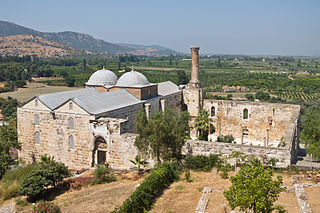
The İsa Bey Mosque, constructed in 1374–75, is one of the oldest and most impressive works of architectural art remaining from the Anatolian beyliks. The mosque is situated on the outskirts of the Ayasluğ Hills at Selçuk, İzmir.

In architecture, a hypostyle hall has a roof which is supported by columns.

Kasaba or Kasabaköy is a village in the Kastamonu District, Kastamonu Province, Turkey. Its population is 84 (2021). It is 17 kilometres outside Kastamonu, Turkey. It had a population of about 23,000 in 1905, when it had considerable local trade, but has since shrunk to only a few dozen households. Kasaba does not contain any ancient sites but does have an old mosque, the Mahmut Bey Camii, built by a representative of Isfendiyarid dynasty in the second half of the 14th century.
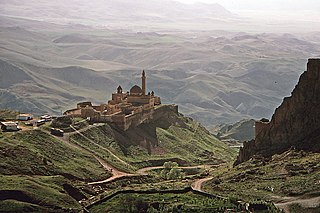
Ishak Pasha Palace is a semi-ruined palace and administrative complex located in the Doğubeyazıt district of Ağrı province of eastern Turkey.

Divriği Great Mosque and Hospital is a mosque and hospital complex built in 1228–1229 by the local dynasty of the Mengujekids in the small Anatolian town of Divriği, now in Sivas Province, Turkey. The complex is located in the upper town, below the citadel. The exquisite stone carvings and eclectic architecture of the complex places it among the most important works of architecture in Anatolia and led to its inclusion on UNESCO's World Heritage List in 1985.

Turkish art refers to all works of visual art originating from the geographical area of what is present day Turkey since the arrival of the Turks in the Middle Ages. Turkey also was the home of much significant art produced by earlier cultures, including the Hittites, Ancient Greeks, and Byzantines. Ottoman art is therefore the dominant element of Turkish art before the 20th century, although the Seljuks and other earlier Turks also contributed. The 16th and 17th centuries are generally recognized as the finest period for art in the Ottoman Empire, much of it associated with the huge Imperial court. In particular the long reign of Suleiman the Magnificent from 1520 to 1566 brought a combination, rare in any ruling dynasty, of political and military success with strong encouragement of the arts.
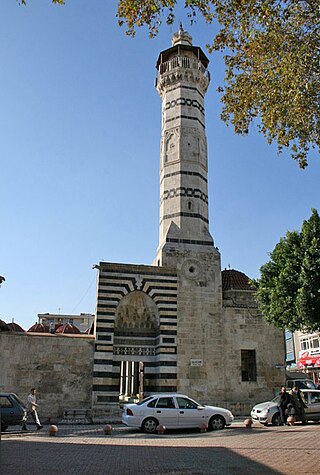
The Great Mosque of Adana, also known as the Ramazanoglu Mosque Turkish: Ramazanoğlu Camii), is a 16th-century mosque in Adana, Turkey. It forms part of a complex (külliye) that includes a madrasah and a mausoleum (türbe). The buildings are on Kızılay street, next to the Ramazanoğlu Hall.

The Grand Mosque of Bursa is a historic mosque in Bursa, Turkey. It was commissioned by the Ottoman Sultan Bayezid I to commemorate his great victory at the Battle of Nicopolis and built between 1396 and 1399. The mosque is a major monument of early Ottoman architecture and one of the most important mosques in the city, located in the heart of the old city alongside its historic markets.

Youssef Dey Mosque, also known as Al B'chamqiya, is a 17th-century mosque in Tunis, Tunisia, located in Medina area of the city. The mosque is considered significant as it was the first Ottoman-Turkish mosque to be built in Tunis.

Seljuk architecture comprises the building traditions that developed under the Seljuk dynasty, when it ruled most of the Middle East and Anatolia during the 11th to 13th centuries. The Great Seljuk Empire contributed significantly to the architecture of Iran and surrounding regions, introducing innovations such as the symmetrical four-iwan layout and the first widespread creation of state-sponsored madrasas. Their buildings were generally constructed in brick, with decoration created using brickwork, tiles, and carved stucco.

Eşrefoğlu Mosque is a 13th-century mosque in Beyşehir, Konya Province, Turkey It is situated 100 metres (330 ft) north of the Beyşehir Lake

Sultan Han is a large 13th-century Seljuk caravanserai located in the town of Sultanhanı, Aksaray Province, Turkey. It is one of the three monumental caravanserais in the neighbourhood of Aksaray and is located about 40 km (25 mi) west of Aksaray on the road to Konya.

İskender Pasha Mosque, a.k.a. Terkim Masjid is a historic mosque located in Fatih district in Istanbul, Turkey.
Kastamonu Ethnography Museum is a museum in Kastamonu, Turkey

Sivrihisar Grand Mosque is a historical mosque in Sivrihisar, Turkey.

The Afyon Grand Mosque is a historical mosque in Afyonkarahisar in Afyonkarahisar province, Turkey.
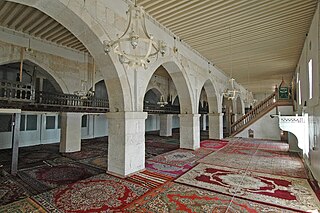
Ermenek Grand Mosque is located on the outskirts of Ermenek Castle on an outcrop that overlooks the city of Ermenek. The mosque was built by Mahmud Bey of the Karamanids in 1302AD (702AH), as inscribed in Sülüs-style calligraphy on the original door wings between the antechamber and the prayer hall.
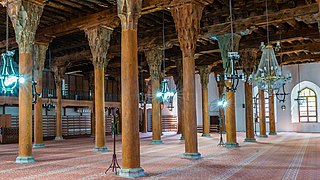
The Wooden Hypostyle Mosques of Medieval Anatolia are a World Heritage Site consisting of five Seljuk mosques in Anatolia dating back to the late 13th and mid-14th centuries.





































